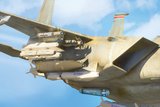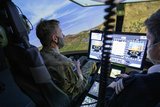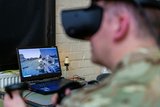How Next-Generation Optical Systems Are Transforming Multi-Domain Operations (Studio)
Brought to you in partnership with Raytheon ELCAN
In the multi-domain battlespace, commanders need optical solutions that can thrive in all scenarios, even temperature and terrain extremes. Raytheon ELCAN’s systems are designed for precision in every mission, adapting to technological and operational challenges to deliver actionable intelligence.
The US and its allies are focused on the strategic priorities of Multi-Domain Operations (MDO), also known as Joint All-Domain Command and Control (JADC2). This changing strategic backdrop is driven by the rise of peer and near-peer rivals across the globe.
Harnessing Technology for Enhanced Optics
In this unpredictable landscape, adaptability and durability are key. These are key focuses for the Raytheon ELCAN optics range, including the Specter sights line, which is now fielded with more than 50 allied nations. These demands also drive the company’s work in head-up displays, infrared countermeasures, missile and weapon guidance and beyond.
Cutting-edge optics will increase mass and quality within the MDO environment, said Dr Alex Rose-Parfitt, engineering director for Raytheon UK. Adding additional platforms is expensive and time-consuming. However, inserting additional sensors within a system can quickly provide a technological boost.
Technology is evolving to meet the demands of an evolving battlespace, said Rose-Parfitt. New capabilities are becoming standard requests, such as onboard target acquisition and cyber-hardened integrated communication capabilities. For example, products like the Specter Digital Fire Control Sight (DCFS) have a digital display injected in the field of view, along with an onboard ballistic computer to enable swift evaluation of environmental data and beyond.
The system still needs to provide that phenomenal level of accuracy, no matter the environment.— Dr Alex Rose-Parfitt, engineering director for Raytheon UK
Requirements for reduced size, weight and power (SWAP) are putting more capability into smaller packages, supported by the move from analogue to digital, Rose-Parfitt noted. This is underpinned by advances in manufacturing and design, which are driving capability improvements.
For instance, Rose-Parfitt highlighted the company’s investment in modelling capability and simulation.
‘This can then drive a series of better operating systems, be that reduced weight, higher optical efficiencies and optical paths, producing clearer data and information for the end user,’ he explained.
Ensuring Reliability Across Diverse Environments
Adaptability is key. In today’s battlespace, optical systems must work wherever warfighters need them, whether in the humidity of jungle environments, Arctic cold, or the shock and vibration of missiles, aircraft and space systems.
‘The system still needs to provide that phenomenal level of accuracy,’ no matter the environment, said Rose-Parfitt.
‘If there is any degradation, think about the impact that could have on the rest of the mission. If you haven’t been able to get that accurate optical data, that optical imaging piece, think about what that means in terms of targeting systems or the optical system within a rifle sight or a munition.’
Optical systems must operate reliably and repeatedly. Raytheon ELCAN delivers this through its design and manufacturing processes, including digital design, modelling and simulation, which helps fully understand how the systems and components will perform in real-world environments.
Digital engineering is central to such advances in manufacturing, Rose-Parfitt said, providing toolsets to develop and evaluate concepts far more quickly. This enables the company to produce systems that deliver for individual customers, no matter their operational needs.
‘You can now have a far more detailed conversation with your customer than ever before, in terms of how you start to tweak different aspects of a concept, the impact that might have on the overall cost of a system, its size, speed of operation, etc.’
Raytheon ELCAN leverages depth and breadth in cross-mission experience and vertical integration to create a unique optical range, one built to adapt to a changing battlespace. Such high-end optics are also increasingly vital to other platforms, such as high-precision autonomous vehicles. This expanding interest is likely to be seen in the military domain and beyond, including various aspects of commercial industry.
Adaptability is central to partnerships with customers today, no matter the product or focus, Rose-Parfitt said. Close collaboration is a core aspect of delivering optics that meet the mission at hand.
For example, Rose-Parfitt is seeing more “pre-engagement” with customers, where they can begin to visualise the product and understand how it might work even before requirements are fully established. ‘There’s far more of a two-way collaboration now.’
Anticipating Future Needs in Optical Technology
The technology must evolve for the future, adapting to changes in the MDO battlespace, including the unexpected. Faster sensors will demand higher-resolution optics. The systems will leverage more than IR, moving to multispectral and hyperspectral systems, while other sensing modalities like LiDAR will play a key role as autonomous systems expand as a focus.
Materials science is a crucial element of successful design in optics, in delivering cutting-edge thin film coatings, for example, or in crafting survivability at extreme temperatures. Raytheon ELCAN invests heavily in advancing its materials capabilities, noted Rose-Parfitt, and works with universities and other partners to stay ahead of technological advances.
‘The slightest aberration within the surface has such an impact within the optical image that you get,’ he said. ‘Right from raw material through to end product, getting that consistency within the material is vital.’
Discover how Raytheon ELCAN has been delivering high‐precision optical systems for the most demanding challenges in the world.
More from Studio
-
![Combat-proven capabilities: How precision-strike systems are evolving for tomorrow’s battlespace (podcast)]()
Combat-proven capabilities: How precision-strike systems are evolving for tomorrow’s battlespace (podcast)
Combat-tested technology is being reshaped to counter A2/AD threats, reduce reliance on GPS and enable faster, more autonomous targeting in complex environments. In this special podcast, experts explain how the evolving threat landscape is shaping next-generation strike capabilities.
-
![Energy evolution: How laser defence systems are powering the next phase of air defence (podcast)]()
Energy evolution: How laser defence systems are powering the next phase of air defence (podcast)
Laser-based air defence is moving from promise to deployment as global threats evolve. In this special podcast, we explore how high-energy laser systems are reshaping interception strategies.
-
![Intelligence advantage: How real-time GEOINT is reshaping military decision-making (Studio)]()
Intelligence advantage: How real-time GEOINT is reshaping military decision-making (Studio)
In today’s contested operational environment, adaptability is key. The new Geospatial-Intelligence as a Service (GEO IaaS) solution from Fujitsu and MAIAR empowers militaries by enabling intelligence advantage, combining advanced technology with human expertise to deliver actionable insights.
-
![Training Together: Unlocking Educational Excellence through Military and Industry Collaboration (Studio)]()
Training Together: Unlocking Educational Excellence through Military and Industry Collaboration (Studio)
Military training is ultimately about people. At Capita, training programmes are built on close engagement with partners, delivering an educational approach that can adapt to individual needs, cultivate leadership – and drive wider cultural change.
-
![Enhancing Military Training Through Digital Technology (Studio)]()
Enhancing Military Training Through Digital Technology (Studio)
Digital technologies offer huge opportunities for defence training. However, militaries must adopt an agile approach, placing the needs of their organisations and personnel at the centre of their efforts.
-
![Layered Defence: How new technologies are enhancing armoured vehicle survivability and manoeuvrability (Studio)]()
Layered Defence: How new technologies are enhancing armoured vehicle survivability and manoeuvrability (Studio)
As modern threats evolve, armoured fighting vehicles face a new era of challenges, from loitering munitions to kinetic energy projectiles. Advances in active, passive, and reactive protection systems are crucial to ensuring battlefield dominance, freedom of manouver and vehicle survivability.

























